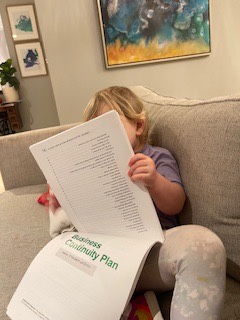As a state and federal regulator for eight years, credit union directors would sometimes come up during conferences to show me the original membership card in their wallet. The important part was the number on the card. Whether it was a single digit or other very low numeral, it validated the owner’s presence and belief at the cooperative’s founding.
Many credit unions summarize their beginning under the About section on their web sites. The theme is that from a few committed persons and minimal dollars, see how far we have come today.
Jim Blaine presented the SECU (NC) founding story in a recent post. A few excerpts provide you a flavor of his imitable style as he contrasts the official version with one member’s reality.
Creation stories are intended to provide us with an explanation and some reassurance that “stuff doesn’t just happen”. These stories are often called “creation myths”, or that fancy word “cosmogony”. . .
Folks at SECU for decades have gathered around the campfire to hear our creation story… “On June 4, 1937, 17 state employees and teachers in Raleigh pooled their meager resources of $437 to form State Employees’ Credit Union…” and the rest is history. Sounds almost like a religion or cult following doesn’t it? Well, for some of us it is…
But, as with most idealistic ventures, there is usually a back story. Way-back-when, I received an enlightening letter from long-time member Paul Wright. . .which begins:
“Back in 1932 I was a liquidating accountant for the State Banking Department. Mr. Gurney Hood was Commissioner of Banks and we had about 10 accountants and 12 or so bank examiners – all the banks were in trouble back then.”
You can read the specific impetus driving this unusual organizational effort in the full blog which concludes with Jim’s observation:
😎 Well, I did get a “kick” out of the letter and it did not in any way tarnish my belief in those “17 apostles”, with $437 who believed, with great purpose, that they could “capitalize on the character of their coworkers and help each other attain a better economic status.”
Wanted to share the “TRUE STORY” with you because today: 1) many credit unions – and one in particular – seem to have “forgotten” why they were created, 2) seem to have “forgotten” who they were created to serve, and 3) seem to have “forgotten” that most of their member-owners still often live in a “paycheck-to-paycheck”, “lend me $10 ’til payday” world of economic stress….… and of course, wanted to 4) remind the bankers that from its “creation” all SECU was ever trying to do was to save them from themselves… (still trying!)
Future Stories
History matters, whether factual or embellished by time and future events. It gives perspective on present circumstances and hope for how we might envision future opportunities.
But sometimes the always changing events in which we live cause some to say they have had enough. The forces driving the profession in which I labor are just too overwhelming. I’m no longer comfortable and need to get out.
An example is the resignation last week of Harvard’s football coach of 30 years. He had an extraordinary record as summarized in this article:
He ended his career with 200 wins, and, with a 17-9 victory over Dartmouth on Oct. 28, surpassed Yale’s Carm Cozza to set the record for Ivy League coaching wins. During his tenure, Harvard won 10 Ivy League titles and defeated the archival Yale Bulldogs 19 times, including nine straight from 2007-2015.
He also led the Crimson to three undefeated seasons — in 2001, 2004, and 2014 — leading Harvard to amass the sixth-best winning percentage in all of Division I football since 2000. Throughout his career, he won the New England Coach of the Year award eight times and was named a finalist for the Eddie Robinson Award — awarded to the top coach in the Football Championship Subdivision (FCS) — on five occasions.
So why did he retire, still young and in many ways at the top of his game? The driving motivation was changes in the college football model, specifically paying players through the “name, image, likeness” opportunity. Here is his blunt assessment:
“College football is changing dramatically and certainly not for the better,” Murphy said. “When people ask my opinion of what’s going on in college football, I give them a very simple explanation. It absolutely — positively — is professional football, only without any rules whatsoever.”
Some very successful credit union CEO’s and boards are voicing a similar lament about their industry. The challenges are just too numerous: technology, regulation, changing competition, lack of volunteers, little member loyalty and of course ever pressing competition.
As they look ahead, these CEO’s and boards give up and retire. Change has made it too hard to continue even after demonstrated successes of 40, 50 or 80 years—it is time for them AND the credit union to go, in their future outlook.
Tomorrow I will share an example of one credit union’s “future story” after 66 years of stable and focused growth. It determined it wouldn’t be able to continue and had to merge to continue to serve members.
The difference between the Harvard football coach’s retirement and these credit union leaders is the credit union leaders decided to withdraw from the game. Harvard will find a new coach who will want to tackle the challenges of competing in a time “of no rules.”
Also the credit union decided to give up and transfer all of their ample resources to another organization. It would be similar to the Harvard athletic department confirming Coach Murphy’s insight and declaring, “From now on Harvard is not going to field a football team. So just root for Yale or whatever school you prefer. And any young men who might want to play, don’t apply to Harvard.”
The instances of credit union leaders closing up shop is becoming more widely presented as an acceptable strategy. The decision is oblivious to whatever “creation story” the credit union told its generations of members who created the bountiful legacy that is given away to outsiders who had no role in its success. There is not even an effort to find a new coach.
The other disturbing aspect of these “future rationales” is that sometimes the leaders use the closure to enhance their own personal futures. It would be like Coach Murphy deciding to take all of Harvard’s footballs and memorabilia with him when he leaves saying, I deserve this because I made it all happen.
A college, or for that matter any football team’s future, does not depend on a single coach or even player. There is an institution, an organization, or even a league that supported the decades of every team’s individual efforts. I believe it is time for these supporting organizations and their alumni to speak up. The institutions they built to benefit future generations are being unilaterally shutdown.





